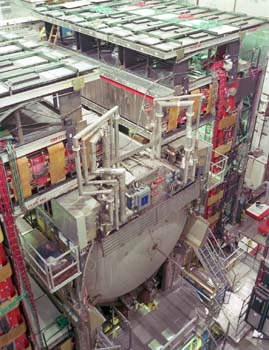| Sun | Mon | Tue | Wed | Thu | Fri | Sat |
|---|---|---|---|---|---|---|
| 1 | 2 | 3 | 4 | 5 | ||
| 6 | 7 | 8 | 9 | 10 | 11 | 12 |
| 13 | 14 | 15 | 16 | 17 | 18 | 19 |
| 20 | 21 | 22 | 23 | 24 | 25 | 26 |
| 27 | 28 | 29 | 30 | 31 |
CATEGORIES
RECENT ENTRIES
BLOG ROLL
Rumors, drawing on science
Unfounded (alas!) rumors had it that Fermilab may have discovered the God particle—the Higgs boson. Plus, some cool particle physics cartoons.
 Well, this would have been big news: a University of Padua physicist blogged last week that he'd heard that Fermilab has discovered the elusive Higgs boson particle—the only particle predicted in the standard atomic model that has yet to be discovered.
Well, this would have been big news: a University of Padua physicist blogged last week that he'd heard that Fermilab has discovered the elusive Higgs boson particle—the only particle predicted in the standard atomic model that has yet to be discovered.
"It reached my ear, from two different, possibly independent sources, that an experiment at the Tevatron is about to release some evidence of a light Higgs boson signal," said the blogger, Tomasso Dorigo (who has a position at Fermilab), setting off sensationally suspenseful speculation that the notoriously discovery-shy particle was found, despite the fact that Dorigo reported it as a rumor, not fact.
Sadly, we God particle-enthusiasts can't celebrate just yet; Judith Jackson, communications director at Fermilab, smashed the rumors like two protons in a particle accelerator: "The Tevatron is functioning fabulously well and at some point [we hope] experiments will present evidence for the Higgs boson," Jackson said in a phone interview, "but these rumors are completely bogus."
 "Bo. Gus," she added, dream-crushingly. Actually she was very nice about the whole thing, which seems to have been taken as a joke at Fermilab.
"Bo. Gus," she added, dream-crushingly. Actually she was very nice about the whole thing, which seems to have been taken as a joke at Fermilab.
"There will be results from Fermilab Tevatron experiments presented at the ICHEP (International Conference on High Energy Physics) Conference in Paris in a couple weeks," Jackson said, but they will refer to limits on what the mass of the Higgs boson may be, not the discovery of the particle itself.
Luckily, the new CERN accelerator in Switzerland, which replaced Fermilab's as the largest accelerator in the world, will perform more and more powerful experiments as it gets up to full speed—hopefully sometime in 2013—and it's the best bet to find the Higgs boson.
Of course, the boson may not exist, in which case science will have to come up with a new theory of the atom. Sad, perhaps, but as New Yorker and Scientific American cartoonist Roz Chast illustrates in these three delightfully unscientific cartoons on particle physics, laymen don't really need to, and probably shouldn't, think too hard about the nitty-gritty of these things, and leave it up to the professionals.
Asher Klein, '11
July 13, 2010
